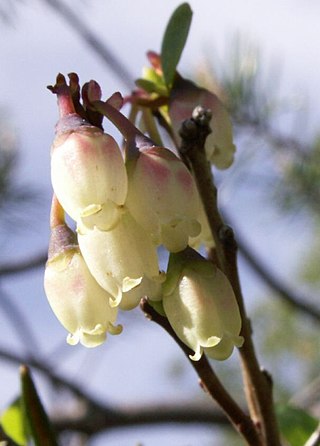
The Ericaceae are a family of flowering plants, commonly known as the heath or heather family, found most commonly in acidic and infertile growing conditions. The family is large, with about 4,250 known species spread across 124 genera, making it the 14th most species-rich family of flowering plants. The many well known and economically important members of the Ericaceae include the cranberry, blueberry, huckleberry, rhododendron, and various common heaths and heathers.

Vaccinium is a common and widespread genus of shrubs or dwarf shrubs in the heath family (Ericaceae). The fruits of many species are eaten by humans and some are of commercial importance, including the cranberry, blueberry, bilberry (whortleberry), lingonberry (cowberry), and huckleberry. Like many other ericaceous plants, they are generally restricted to acidic soils.

Bilberries or blueberries are Eurasian low-growing shrubs in the genus Vaccinium in the flowering plant family Ericaceae that bear edible, dark blue berries. The species most often referred to is Vaccinium myrtillus L., but there are several other closely related species.

Psidium is a genus of trees and shrubs in the family Myrtaceae. It is native to warmer parts of the Western Hemisphere. Many of the species bear edible fruits, and for this reason several are cultivated commercially. The most popularly cultivated species is the common guava, Psidium guajava.

The Atlantic coastal pine barrens is a now rare temperate coniferous forest ecoregion of the Northeast United States distinguished by unique species and topographical features, generally nutrient-poor, often acidic soils and a pine tree distribution once controlled by frequent fires.

Dichorisandra is a genus of perennial monocotyledonous flowering plants in the dayflower family (Commelinaceae). It is found in the Neotropics. The genus is characterised by its slightly zygomorphic flowers with large anthers usually releasing pollen by means of pores at the apex, as well as by its seeds that are embedded in a red or sometimes white aril, and tubers that often form at the tips of the roots. Both morphology and an analysis of DNA sequences indicate it is very closely related to the genus Siderasis.
"Blue huckleberry" refers to either of two plants native to North America:

Gaylussacia brachycera, commonly known as box huckleberry or box-leaved whortleberry, is a low North American shrub related to the blueberry and the other huckleberries. It is native to the east-central United States.
An oak–heath forest is a plant community association and type of forest ecology. It is a deciduous forest type of well-drained, acidic soils, characterized by oaks (Quercus) and plants of the heath family (Ericaceae). It is commonly found in the high elevations of the eastern United States. Such forest areas typically have a dense fibrous root layer at the surface of the soil, and in many areas predominate on south-facing or southwest-facing slopes. Many of the existing oak–heath forests once featured American chestnut as an important canopy species.

Gaylussacia baccata, the black huckleberry, is a common huckleberry found throughout a wide area of eastern North America.

Luziola (watergrass) is a genus of New World in the grass family, native to North and South America including the West Indies.

Huckleberry is a name used in North America for several plants in the family Ericaceae, in two closely related genera: Vaccinium and Gaylussacia.

Vaccinium membranaceum is a species of flowering plant in the heath family Ericaceae, known by the common names thinleaf huckleberry, tall huckleberry, big huckleberry, mountain huckleberry, square-twig blueberry, and ambiguously as "black huckleberry".

Gaylussacia dumosa is a species of flowering plant in the heath family known by the common names dwarf huckleberry, bush huckleberry, and gopherberry. It is native to eastern North America from Newfoundland to Louisiana and Florida. It occurs along the coastal plain and in the mountains.

Gaylussacia frondosa is a species of flowering plant in the heath family known by the common names dangleberry and blue huckleberry. It is native to the eastern United States, where it occurs from New Hampshire to South Carolina.

Vaccinieae is a tribe of over 1000 species in the plant family Ericaceae. The tribe consists of morphologically diverse woody plants. Species within Vaccinieae can be found on all continents except Australia and Antarctica. Genetic analysis indicates that Vaccinieae is not a monophyletic group.

Vaccinioideae is a flowering-plant subfamily in the family Ericaceae. It contains the commercially important cranberry, blueberry, bilberry, lingonberry, and huckleberry.

Gaylussacia bigeloviana, also known as the northern dwarf huckleberry or in French as the gaylussaquier de Bigelow, is a plant species native to the coastal plains of eastern Canada and the eastern United States. It grows from Newfoundland to South Carolina in swamps and marshes, including acidic bogs alongside Sphagnum peatmosses.

Gaylussacia pulchra is a plant species in the family Ericaceae. It is native to the States of Bahia and Minas Gerais in eastern Brazil.
Gaylussacia tomentosa, commonly known as the hairy dangleberry or hairytwig huckleberry, is a plant species native to the coastal plains of the southeastern United States.

















